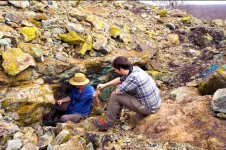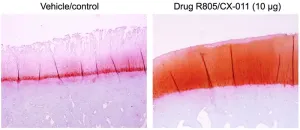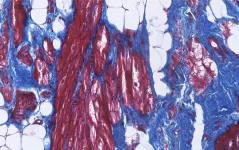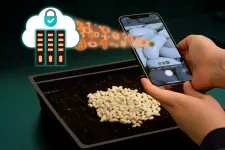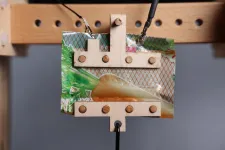(Press-News.org) BIRMINGHAM, Ala. – Memory B cells play a critical role to provide long-term immunity after a vaccination or infection. In a study published in the journal Immunity, researchers describe a distinct and novel subset of memory B cells that predict long-lived antibody responses to influenza vaccination in humans.
These effector memory B cells appear to be poised for a rapid serum antibody response upon secondary challenge one year later, Anoma Nellore, M.D., Fran Lund, Ph.D., and colleagues at the University of Alabama at Birmingham and Emory University report. Evidence from transcriptional and epigenetic profiling shows that the cells in this subset differ from all previously described memory B cell subsets.
The UAB researchers identified the novel subset by the presence of FcRL5 receptor protein on the cell surface. In immunology, a profusion of different cell-surface markers is used to identify and separate immune-cell types. In the novel memory B cell subset, FcRL5 acts as a surrogate marker for positive expression of the T-bet transcription factor inside the cells. Various transcription factors act as master regulators to orchestrate the expression of many different gene sets as various cell types grow and differentiate.
Nellore, Lund and colleagues found that the FcRL5+ T-bet+ memory B cells can be detected seven days after immunization, and the presence of these cells correlates with vaccine antibody responses months later. Thus, these cells may represent an early, easily monitored cellular compartment that can predict the development of a long-lived antibody response to vaccines.
This could be a boon to the development of a more effective yearly influenza vaccine. “New annual influenza vaccines must be tested, and then manufactured, months in advance of the winter flu season,” Lund said. “This means we must make an educated guess as to which flu strain will be circulating the next winter.”
Why are vaccine candidates made so far in advance? Pharmaceutical companies, Lund says, need to wait many weeks after vaccinating volunteers to learn whether the new vaccine elicits a durable immune response that will last for months. “One potential outcome of the current study is we may have identified a new way to predict influenza vaccine durability that would give us an answer in days, rather than weeks or months,” Lund said. “If so, this type of early ‘biomarker’ could be used to test flu vaccines closer to flu season — and moving that timeline might give us a better shot at predicting the right flu strain for the new annual vaccine.”
Seasonal flu kills 290,000 to 650,000 people each year, according to World Health Organization estimates. The global flu vaccine market was more than $5 billion in 2020.
To understand the Immunity study, it is useful to remember what happens when a vaccinated person subsequently encounters a flu virus.
Following exposure to previously encountered antigens, such as the hemagglutinin on inactivated influenza in flu vaccines, the immune system launches a recall response dominated by pre-existing memory B cells that can either produce new daughter cells or cells that can rapidly proliferate and differentiate into short-lived plasmablasts that produce antibodies to decrease morbidity and mortality. These latter B cells are called “effector” memory B cells.
“The best vaccines induce the formation of long-lived plasma cells and memory B cells,” said Lund, the Charles H. McCauley Professor in the UAB Department of Microbiology and director of the Immunology Institute. “Plasma cells live in your bone marrow and make protective antibodies that can be found in your blood, while memory B cells live for many years in your lymph nodes and in tissues like your lungs.
“Although plasma cells can survive for decades after vaccines like the measles vaccine, other plasma cells wane much more quickly after vaccination, as is seen with COVID-19,” Lund said. “If that happens, memory B cells become very important because these long-lived cells can rapidly respond to infection and can quickly begin making antibody.”
In the study, the UAB researchers looked at B cells isolated from blood of human volunteers who received flu vaccines over a span of three years, as well as B cells from tonsil tissue obtained after tonsillectomies.
They compared naïve B cells, FcRL5+ T-bet+ hemagglutinin-specific memory B cells, FcRL5neg T-betneg hemagglutinin-specific memory B cells and antibody secreting B cells, using standard phenotype profiling and single-cell RNA sequencing. They found that the FcRL5+ T-bet+ hemagglutinin-specific memory B cells were transcriptionally similar to effector-like memory cells, while the FcRL5neg T-betneg hemagglutinin-specific memory B cells exhibited stem-like central memory properties.
Antibody-secreting B cells need to produce a lot of energy to churn out antibody production, and they also must turn on processes that protect the cells from some of the detrimental side effects of that intense metabolism, including controlling the dangerous reactive oxygen species and boosting the unfolded protein response.
The FcRL5+ T-bet+ hemagglutinin-specific memory B cells did not express the plasma cell commitment factor, but did express transcriptional, epigenetic and metabolic functional programs that poised these cells for antibody production. These included upregulated genes for energy-intensive metabolic processes and cellular stress responses.
Accordingly, FcRL5+ T-bet+ hemagglutinin-specific memory B cells at Day 7 post-vaccination expressed intracellular immunoglobulin, a sign of early transition to antibody-secreting cells. Furthermore, human tonsil-derived FcRL5+ T-bet+ memory B differentiated more rapidly into antibody-secreting cells in vitro than did FcRL5neg T-betneg hemagglutinin-specific memory B cells.
Lund and Nellore, an associate professor in the UAB Department of Medicine Division of Infectious Diseases, are co-corresponding authors of the study, “A transcriptionally distinct subset of influenza-specific effector memory B cells predicts long-lived antibody responses to vaccination in humans.”
Co-authors with Lund and Nellore are Esther Zumaquero, R. Glenn King, Betty Mousseau, Fen Zhou and Alexander F. Rosenberg, UAB Department of Microbiology; Christopher D. Scharer, Tian Mi, Jeremy M. Boss, Christopher M. Tipton and Ignacio Sanz, Emory University School of Medicine, Atlanta, Georgia; Christopher F. Fucile, UAB Informatics Institute; John E. Bradley and Troy D. Randall, UAB Department of Medicine, Division of Clinical Immunology and Rheumatology; and Stuti Mutneja and Paul A. Goepfert, UAB Department of Medicine Division of Infectious Diseases.
Funding for the work came from National Institutes of Health grants AI125180, AI109962 and AI142737 and from the UAB Center for Clinical and Translational Science.
At UAB, the departments of Microbiology and Medicine, the institutes of Informatics and Immunology, and the Center for Clinical and Translational Science are part of the Marnix E. Heersink School of Medicine
END
Memory B cell marker predicts long-lived antibody response to flu vaccine
These effector memory B cells appear poised for a rapid serum antibody response upon secondary challenge one year later, and evidence shows that the cells in this subset differ from all previously described memory B cell subsets.
2023-03-22
ELSE PRESS RELEASES FROM THIS DATE:
Copper artifacts unearth new cultural connections in southern Africa
2023-03-22
COLUMBIA, Mo. – Chemical and isotopic analysis of copper artifacts from southern Africa reveals new cultural connections among people living in the region between the 5th and 20th centuries according to a University of Missouri researcher and colleagues.
People in the area between northern South Africa and the Copperbelt region in central Africa were more connected to one another than scholars previously thought, said Jay Stephens, a post-doctoral fellow in the MU Research Reactor (MURR) Archaeometry Lab.
“Over the past 20 to 30 years, most archaeologists ...
Babies or beauty?
2023-03-22
Have you ever marveled at the vast diversity of life on our planet, from tiny creatures living only a few hours to majestic beings that can survive for centuries? These differences in lifespan, size, and reproductive age are known as life-history strategies, and they have evolved over time as organisms adapt to their environments.
Evolutionary biologists have long been interested in understanding the factors that contribute to the evolution and maintenance of multiple alternative life-history strategies (ALHS) within species that lead to adaptation and novel traits. A new study published in Science Advances has not only revealed that an ALHS in Colias ...
The Protein Society announces its 2023 award winners
2023-03-22
FOR IMMEDIATE RELEASE
March 22, 2023
THE PROTEIN SOCIETY ANNOUNCES ITS 2023 AWARD RECIPIENTS
LOS ANGELES, CA – The Protein Society, the premier international society dedicated to supporting protein research, announces the winners of the 2023 Protein Society Awards, which will be conferred at the 37th Anniversary Symposium, July 13 – 16, 2023, in Boston, Massachusetts. Plenary talks from select award recipients will take place throughout the 3.5-day event. The scientific accomplishments of the awardees, highlighted here as described by their nominators, demonstrate their lasting impact on protein science.
The Carl Brändén Award, sponsored by Rigaku ...
Road noise makes your blood pressure rise – literally
2023-03-22
If you live near a busy road you might feel like the constant sound of roaring engines, honking horns and wailing sirens makes your blood pressure rise. Now a new study published today in JACC: Advances confirms it can do exactly that.
Previous studies have shown a connection between noisy road traffic and increased risk of hypertension. However, strong evidence was lacking, and it was unclear whether noise or air pollution played a bigger role. The new research shows that it is exposure to road traffic noise itself that can elevate hypertension risk.
“We were a ...
Potential relief for osteoarthritis moves to clinical trial after animal studies
2023-03-22
A team of researchers at the Keck School of Medicine of USC have found a drug with the potential for curbing painful hyperinflammation from osteoarthritis, according to results of an animal study.
The findings, published March 22nd in Science Translational Medicine, indicate that a drug compound, R805/CX-011, may modulate an important cell receptor in the body’s immune system, GP130, that signals when antibodies should attack a virus or infection. The animal model studies showed that the drug compound can disrupt the receptor’s over-activation of inflammation, and still manage pain ...
Racial disparities in US drug overdose fatalities significantly higher in 2020
2023-03-22
The first year of the COVID pandemic saw significant increases in drug overdose deaths across the USA, with rates higher than recent trends could have predicted. Research published in the open access journal PLOS Global Public Health, reports trends in drug overdose deaths between 2013-20 across four major drug categories by gender, race and geography. It finds high levels of heterogeneity in overdose patterns across different demographic groups and that the gap in overdose fatalities between black and white individuals continues to widen. Drug prevention and mitigation campaigns should therefore be tailored to specific at-risk groups.
Drug overdose deaths have been ...
From mutation to arrhythmia: desmosomal protein breakdown as an underlying mechanism of cardiac disease
2023-03-22
Mutations in genes that form the desmosome are the most common cause of the cardiac disease arrhythmogenic cardiomyopathy (ACM), which affects one in 2000 to 5000 people worldwide. Researchers from the group of Eva van Rooij now discovered how a mutation in the desmosomal gene plakophilin-2 leads to ACM. They found that the structural and functional changes in ACM hearts caused by a plakophilin-2 mutation are the result of increased desmosomal protein degradation. The results of this study, published in Science Translational Medicine ...
Tackling counterfeit seeds with “unclonable” labels
2023-03-22
Average crop yields in Africa are consistently far below expected, and one significant reason is the prevalence of counterfeit seeds whose germination rates are far lower than those of the genuine ones. The World Bank estimates that as much as half of all seeds sold in some African countries are fake, which could help to account for crop production that is far below potential.
There have been many attempts to prevent this counterfeiting through tracking labels, but none have proved effective; among other issues, such labels have been vulnerable to hacking because of the deterministic ...
Clearing a path for non-invasive muscle therapy for the elderly
2023-03-22
Clearing a path for non-invasive muscle therapy for the elderly
Controlling inflammation enables injured aged muscle recovery via non-invasive mechanical loading, offering promise for the future of mechanotherapies for elderly patients.
By Benjamin Boettner
(BOSTON) — Mechanotherapy, the concept of using mechanical forces to stimulate tissue healing, has been used for decades as a form of physical therapy to help heal injured muscles. However, the biological basis and optimal settings for mechanotherapies are still poorly understood, ...
Biodegradable artificial muscles: going green in the field of soft robotics
2023-03-22
Stuttgart, Linz, Boulder – Artificial muscles are a progressing technology that could one day enable robots to function like living organisms. Such muscles open up new possibilities for how robots can shape the world around us; from assistive wearable devices that can redefine our physical abilities at old age, to rescue robots that can navigate rubble in search of the missing. But just because artificial muscles can have a strong societal impact during use, doesn’t mean they have to leave a strong ...
LAST 30 PRESS RELEASES:
Numbers in our sights affect how we perceive space
SIMJ announces global collaborative book project in commemoration of its 75th anniversary
Air pollution exposure and birth weight
Obstructive sleep apnea risk and mental health conditions among older adults
How talking slows eye movements behind the wheel
The Ceramic Society of Japan’s Oxoate Ceramics Research Association launches new international book project
Heart-brain connection: international study reveals the role of the vagus nerve in keeping the heart young
Researchers identify Rb1 as a predictive biomarker for a new therapeutic strategy in some breast cancers
Survey reveals ethical gaps slowing AI adoption in pediatric surgery
Stimulant ADHD medications work differently than thought
AI overestimates how smart people are, according to HSE economists
HSE researchers create genome-wide map of quadruplexes
Scientists boost cell "powerhouses" to burn more calories
Automatic label checking: The missing step in making reliable medical AI
Low daily alcohol intake linked to 50% heightened mouth cancer risk in India
American Meteorological Society announces Rick Spinrad as 2026 President-Elect
Biomass-based carbon capture spotlighted in newly released global climate webinar recording
Illuminating invisible nano pollutants: advanced bioimaging tracks the full journey of emerging nanoscale contaminants in living systems
How does age affect recovery from spinal cord injury?
Novel AI tool offers prognosis for patients with head and neck cancer
Fathers’ microplastic exposure tied to their children’s metabolic problems
Research validates laboratory model for studying high-grade serous ovarian cancer
SIR 2026 delivers transformative breakthroughs in minimally invasive medicine to improve patient care
Stem Cell Reports most downloaded papers of 2025 highlight the breadth and impact of stem cell research
Oxford-led study estimates NHS spends around 3% of its primary and secondary care budget on the health impacts of heat and cold in England
A researcher’s long quest leads to a smart composite breakthrough
Urban wild bees act as “microbial sensors” of city health.
New study finds where you live affects recovery after a hip fracture
Forecasting the impact of fully automated vehicle adoption on US road traffic injuries
Alcohol-related hospitalizations from 2016 to 2022
[Press-News.org] Memory B cell marker predicts long-lived antibody response to flu vaccineThese effector memory B cells appear poised for a rapid serum antibody response upon secondary challenge one year later, and evidence shows that the cells in this subset differ from all previously described memory B cell subsets.



